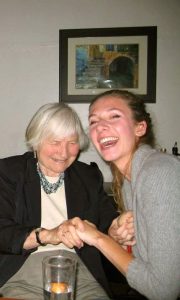Assignment 3.7 – Hyperlinking GGRW
Write a blog that hyper-links your research on the characters and symbols in GGRW according to the pages assigned to you. Be sure to make use of Jane Flicks’ GGRW reading notes on your reading list.
I have chosen pages 166 – 176 in the 1993 edition of Green Grass, Running Water for this assignment. Every time I read this section, I am struck by the complexity and subtlety contained within King’s writing. These chapters explore the relationship between Eli Stand Alone and Karen and the harmful effects of the Western genre, before transitioning to focus on Portland and Charlie Looking Bear in Hollywood.
Eli Stand Alone and Karen
This chapter begins with Eli Stands Alone reading a Western novel. As Jane Flick notes, Eli’s name is reminiscent of Elijah Harper, the man “who blocked the Meech Lake Accord by being the standout vote in the Manitoba legislature.” (150) Similarly, Eli is taking a stand against the forces that want to build a dam on his property and tear down his mother’s house. He is refusing to move or give in to the demands of Clifford Sifton and, much like Harper, is demanding that First Nations be consulted on the fate of their lands.
In this section, Eli is enjoying a quiet night alone in his mother’s house, trying to pass the time with a Western novel. Even before getting into the story, he can accurately predict the direction the plot will take. The white woman and the Indian will fall madly in love, but end up torn apart by the novel’s end. They will not be allowed to sleep together because “Western writers seldom let Indians sleep with whites.” (166) Either way, these characters will not be allowed to have a happy ever after.
Interspersed with Eli’s reading are flashbacks to his relationship with Karen, a white woman he met while studying at the University of Toronto. The realities of their relationship provide an interesting comparison for the fictive representation within the Western novel. Of all the mixed relationships portrayed within GGRW, this is perhaps the least offensive one. Yes, Karen seems to “love Eli at least partly for his Indianness” (Hoffman, 129) and she does whisper that he is “her Mysterious Warrior” (coincidentally the title of the Western) one night in bed, but overall their relationship seems fairly healthy.
However, this chapter illustrates that every relationship between whites and First Nations is influenced by the harmful stereotypes perpetuated in Westerns and other pop culture sources. In the end, King chooses to end Karen and Eli’s romance with tragedy by killing Karen in a car crash. Eli, despite hoping that the novel would turn out differently from every other Western, ends up throwing the book away in disgust.
The Mysterious Warrior
The name of the Western that Eli is reading and Charlie Looking Bear is watching on TV. This story is “a composite of Western films” in which “the title alludes to The Mystic Warrior, a television movie based on Ruth Beebe Hill’s Hanta Yo.” (Flick, 158) This novel attempts to accurately portray the Sioux culture, yet ultimately ends up contributing to “the Plains Indian myth” (Simons) and igniting outrage and protest from Native American groups. This is the story that the Four Indians are attempting to “fix” in GGRW.
The De Soto
When Eli and Karen make their trip back to Alberta for the annual Sundance, they do so in a De Soto car. Jane Flick’s reading notes state that “like so many American cars this is named for an explorer, Hernando De Soto.” (Flick, 158) This Spanish conquistador wrought cultural havoc throughout the Americas and is known for “discovering” the Mississippi River.
During the drive, Eli “liked being behind the wheel of a De Soto” and observes how the car “flew along the roads, floating over the landscape like a bird in flight.” (168) However, once the car leaves the paved asphalt road, it begins to behave strangely. On the gravel road it “lurched and wallowed through the potholes” and pitched “forward on its nose, as if it had been shot.” (168) Much like its namesake, the car left behind a visible path of destruction, in the form of “a huge, towering dust plume” that “rose off the road into the night sky.” (168) There are also mentions of Eli stopping the car to let it “cool down” after the rough journey. Interestingly, De Soto died of fever after making his storied voyage across the Mississippi River.
Another interaction to notice is Norma’s reaction to the De Soto once Eli and Karen pull in to camp. Upon seeing the car, she “looked at the De Soto for a moment, shook her head, and went back inside.” (169) Norma is a pillar of native stability and advocate for tradition. Her apparent dislike of the De Soto could stem from her mistrust of Western forces of modernity, forces that Eli seems only too happy to embrace.
Four Corners
The name of this seedy establishment is an ironic allusion to the Four Corners site where Arizona, New Mexico, Colorado, and Utah meet. The number four is not only an important symbol in this novel, but for native populations as a whole. In real life, Four Corners is located in a remote part of the tribal lands of Navajo Nation. In the novel, it is also located in a remote part of the city, yet the similarities seem to end there. The Four Corners is a burlesque club with a Pocahontas strip act. Portland Looking Bear takes a job as a background dancer here in hopes of being “discovered.” It is a smoky club with a sticky floor and a pungent smell (175). The “rich cultural associations” (Flick, 158) that this site has in real life are ironically contrasted with the crude depictions of First Nations culture taking place at the strip club.
Works Cited
“25 years since Elijah Harper said ‘no’ to the Meech Lake Accord.” CBC News, 11 June 2015, http://www.cbc.ca/news/canada/manitoba/25-years-since-elijah-harper-said-no-to-the-meech-lake-accord-1.3110439.
“Clifford Sifton and his policies.” CIC, 1 July 2006, http://www.cic.gc.ca/english/resources/publications/legacy/chap-2.asp#chap2-2.
“Discover Navajo Nation homepage.” Discover Navajo, http://www.discovernavajo.com. Accessed 18 Nov. 2016.
Flick, Jane. “Reading Notes for Thomas King’s Green Grass Running Water.” Canadian Literature, pp. 161-162. (1999). Web. Accessed 18 Nov. 2016.
“Genre – “The Western.” YouTube, uploaded by Stephen DaVega, 19 Oct. 2009, https://www.youtube.com/watch?v=lNHLkcRcazQ.
“Hernando de Soto – Mini Biography.” YouTube, uploaded by BIO, 8 Jul. 2013. https://www.youtube.com/watch?v=NDH_pB6DzNY.
Hoffman, Elizabeth. “MacGyvering Pop Culture: Blending Traditions in Canada.” American Indians and Popular Culture, vol. 1, 2012, pp. 128-129. Web. Accessed 18 Nov. 2016.
King, Thomas. Green Grass Running Water. Toronto: Harper Collins, 1993. Print.
Simons, Anna. “Perpetuating an American Stereotype.” The Harvard Crimson, 20 March 1979, http://www.thecrimson.com/article/1979/3/20/perpetuating-an-american-stereotype-pbfbirst-there.
Webber, Will. “The Four Corners Monument is a simple, unique curiosity.” The New Mexican, 31 Dec. 2014. http://www.santafenewmexican.com/outdoors/the-four-corners-monument-is-a-simple-unique-curiosity/article_d6727a19-ef8d-50cc-b781-655876088cad.html.

